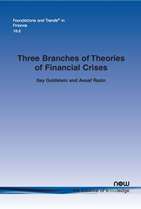Three Branches of Theories of Financial Crises
By Itay Goldstein, University of Pennsylvania, the Wharton School, USA, itayg@wharton.upenn.edu | Assaf Razin, Tel Aviv University, Eitan Berglas School of Economics, Israel, razin@post.tau.ac.il
Abstract
In this monograph, we review three branches of theoretical literature on financial crises. The first deals with banking crises originating from coordination failures among bank creditors. The second deals with frictions in credit and interbank markets due to problems of moral hazard and adverse selection. The third deals with currency crises. We discuss the evolutions of these branches in the literature, and how they have been integrated recently to explain the turmoil in the world economy during the East Asian crises and in the last few years. We discuss the relation of the models to the empirical evidence and their ability to guide policies to avoid or mitigate future crises.
Three Branches of Theories of Financial Crises
Three Branches of Theories of Financial Crises presents basic frameworks linked to the broad topic of financial crises and describes some of the directions in which they influenced the literature and the way they relate to recent events. The authors also address some of the policy challenges, shedding light on them using the analytical tools at hand so that this survey will help to highlight the basic underlying forces that have been studied in the literature for over three decades in a simple and transparent way. It will be an easy and accessible source to the many economists who are interested in exploring the topic of financial crises following recent events.
After the Introduction, Section 2 reviews the literature on banking crises and panics. This literature is perhaps most directly linked to the concept of crises. While Section 2 emphasizes fragility faced by financial institutions due to coordination failures by their creditors, Section 3 reviews models that analyze frictions in loans extended by financial institutions and other lenders. Overall, the models of Sections 2 and 3 highlight fragility on the different sides of the balance sheet of a financial institution. Another literature that evolved independently is focused on currency crises. Traditionally, these were viewed as a separate phenomenon, unrelated to banking crises, but more recently the literatures have moved towards each other. Section 4 reviews models of currency crises and Section 5 provides concluding remarks.

Addendum Q and A | 0500000049_Addendum.pdf
These Questions and Answers about the article Three Branches of Theories of Financial Crises are published as an addendym to I. Goldstein and A. Razin, "Three Branches of Theories of Financial Crises," Foundations and Trends® in Finance, vol. 10, no. 2, pp. 113-180, Dec. 2015. doi: 10.1561/0500000049.